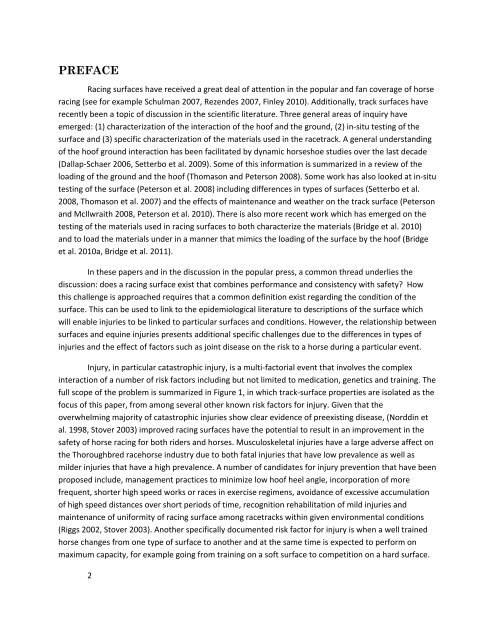Retired Racehorses
tfrr_reportandappendicesfinal
tfrr_reportandappendicesfinal
- No tags were found...
You also want an ePaper? Increase the reach of your titles
YUMPU automatically turns print PDFs into web optimized ePapers that Google loves.
PREFACE<br />
Racing surfaces have received a great deal of attention in the popular and fan coverage of horse<br />
racing (see for example Schulman 2007, Rezendes 2007, Finley 2010). Additionally, track surfaces have<br />
recently been a topic of discussion in the scientific literature. Three general areas of inquiry have<br />
emerged: (1) characterization of the interaction of the hoof and the ground, (2) in‐situ testing of the<br />
surface and (3) specific characterization of the materials used in the racetrack. A general understanding<br />
of the hoof ground interaction has been facilitated by dynamic horseshoe studies over the last decade<br />
(Dallap‐Schaer 2006, Setterbo et al. 2009). Some of this information is summarized in a review of the<br />
loading of the ground and the hoof (Thomason and Peterson 2008). Some work has also looked at in‐situ<br />
testing of the surface (Peterson et al. 2008) including differences in types of surfaces (Setterbo et al.<br />
2008, Thomason et al. 2007) and the effects of maintenance and weather on the track surface (Peterson<br />
and McIlwraith 2008, Peterson et al. 2010). There is also more recent work which has emerged on the<br />
testing of the materials used in racing surfaces to both characterize the materials (Bridge et al. 2010)<br />
and to load the materials under in a manner that mimics the loading of the surface by the hoof (Bridge<br />
et al. 2010a, Bridge et al. 2011).<br />
In these papers and in the discussion in the popular press, a common thread underlies the<br />
discussion: does a racing surface exist that combines performance and consistency with safety? How<br />
this challenge is approached requires that a common definition exist regarding the condition of the<br />
surface. This can be used to link to the epidemiological literature to descriptions of the surface which<br />
will enable injuries to be linked to particular surfaces and conditions. However, the relationship between<br />
surfaces and equine injuries presents additional specific challenges due to the differences in types of<br />
injuries and the effect of factors such as joint disease on the risk to a horse during a particular event.<br />
Injury, in particular catastrophic injury, is a multi‐factorial event that involves the complex<br />
interaction of a number of risk factors including but not limited to medication, genetics and training. The<br />
full scope of the problem is summarized in Figure 1, in which track‐surface properties are isolated as the<br />
focus of this paper, from among several other known risk factors for injury. Given that the<br />
overwhelming majority of catastrophic injuries show clear evidence of preexisting disease, (Norddin et<br />
al. 1998, Stover 2003) improved racing surfaces have the potential to result in an improvement in the<br />
safety of horse racing for both riders and horses. Musculoskeletal injuries have a large adverse affect on<br />
the Thoroughbred racehorse industry due to both fatal injuries that have low prevalence as well as<br />
milder injuries that have a high prevalence. A number of candidates for injury prevention that have been<br />
proposed include, management practices to minimize low hoof heel angle, incorporation of more<br />
frequent, shorter high speed works or races in exercise regimens, avoidance of excessive accumulation<br />
of high speed distances over short periods of time, recognition rehabilitation of mild injuries and<br />
maintenance of uniformity of racing surface among racetracks within given environmental conditions<br />
(Riggs 2002, Stover 2003). Another specifically documented risk factor for injury is when a well trained<br />
horse changes from one type of surface to another and at the same time is expected to perform on<br />
maximum capacity, for example going from training on a soft surface to competition on a hard surface.<br />
2


